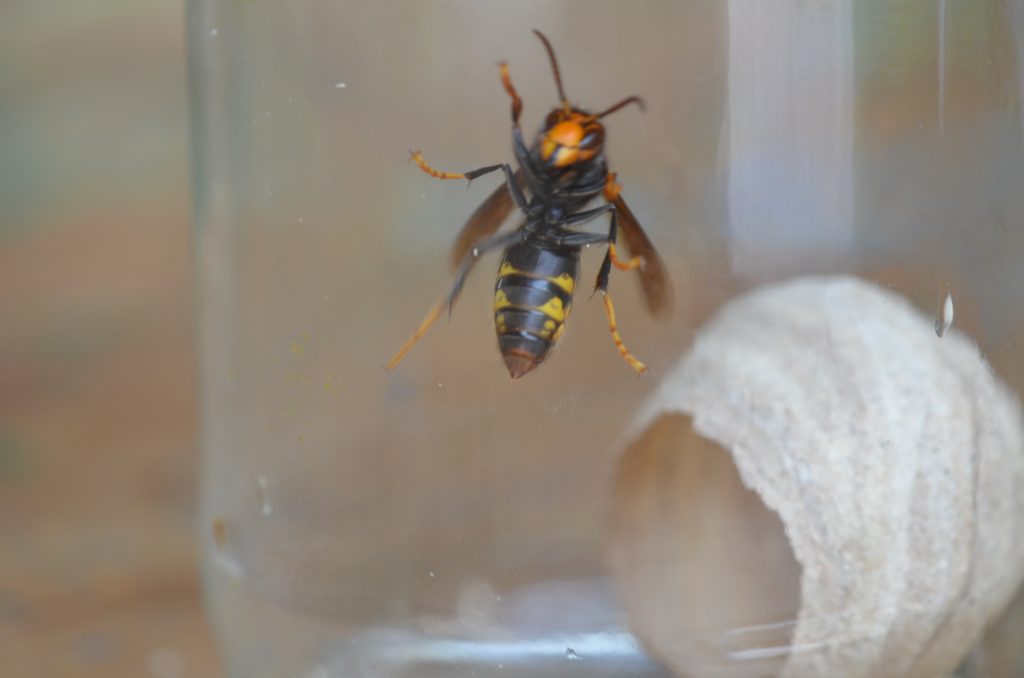We all know that Asian hornets - Vespa Velutina - put a lot of pressure on the colonies. In principle, such pressure leads to a weakened colony, which can no longer operate normally. But what is the real impact on the hive? At what point can we consider it to be a significant pressure? Can we measure the effects of Asian Hornet predation on the hives?
Asian Hornet pressure on hives
By the end on the 2019 season, I noticed a very important drop in brood volume in my apiary. It was as if the queen had stopped laying! I thought it may have something to do with the honey harvest. Without the supers, the bees must have been confined into the hive body. But looking closer, this drop started on July 27th, whereas the harvest took place on August 2nd. My hypothesis was wrong. Looking at my notes, I came up with another option: at the end of July, I had noticed an increase in hornet pressure.

The pressure of Asian Hornets on the apiary was relatively strong in 2019. This apiary was part of a predation monitoring programme run by the ADA Nouvelle Aquitaine (Association for Beekeeping Development). The data shows up to 7 hornets per hive. They also confirm the beginning of predation around August 25.


With this information, the cause and effect relationship seems to be clearer. However, in order to effectively confirm the effect of Asian Hornet predation on brood development, we should compare it to other apiaries. So let’s do it! We will pick three other apiaries in the region. They have different predation levels and as their hives are also equipped with internal sensors, we can effectively compare their brood levels.
Comparison between these apiaries
The three apiaries are located less than 30 km from each other. Each of them has its own specificities regarding the Asian Hornet.
- Parbayse is an apiary located in the middle of the forest and not very affected by hornets.
- Beaumont is an apiary located in town, relatively predated but equipped with an electric hornet trap.
- Lescar is an apiary also fairly predated but the fact that there are 25 hives limits the pressure on each colony.
The comparison shows very clearly that the effect on brood volume is not the same for all apiaries. The difference is even quite large in September and October. Those with a low pressure or a better control have more brood and for longer periods of time.

As winter arrives, however, we can see a synchronous movement of all these apiaries to limit the egg-laying process. The inflection is even clearer around November 15. This is also another argument in favour of this comparison. The apiaries are close to each other and are more or less in the same environment. The difference between them in this season is therefore very likely related to the Hornet presence.
The necessary steps to compensate for the pressure
Observing this strong drop in brood volume confirmed the need for exceptional feeding. The interventions that were carried out made it possible to keep each hive until spring.
Dealing with the Hornet threat is not that simple. However, once the impact is characterized, appropriate choices can be made to better manage the risk.
In conclusion
This example illustrates the implementation of a decision support tool for a better management of the apiary. The measurements first revealed a pronounced and abnormal drop in the brood volume. Then this observation was corroborated by comparison with the three other apiaries. As the effect of Asian Hornet predation was confirmed, an adapted feeding system was implemented. All colonies survived the winter and recovered normally in the spring.
References
- How to install a temperature sensor in your hive
- Predation of the invasive Asian Hornet affects foraging activity and survival probability of honeybees in Western Europe
- Defensive behaviour of Apis mellifera against the invasive Asian Hornet in south-west of France
Also read
The asian hornet queen arrival in the springtime


